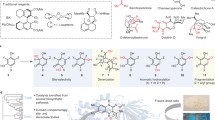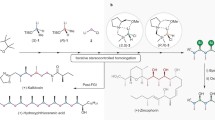Summary
A series of analogous arrays of small, non-peptidyl, non-oligomeric compounds were synthesized on polystyrene resin. With the aid of a functionally differentiated phenolic scaffold, the batch preparation of unique benzamide and urea resins was accomplished, which were further derivatized in modified 96-well plates. An efficient cleavage reaction of the phenyl benzoate link enabled the isolation of more than 600 phenolic compounds in milligram quantities that were suitable for direct biological screening. The technology described herein represents a facile, economical approach to non-peptidyl chemical diversity.
Similar content being viewed by others
References
Moos, W.H., Green, G.D. and Pavia, M.R.,Recent advances in the generation of molecular diversity, Annu. Rep. Med. Chem., 28 (1993) 315–324.
Gracheck, S.J., Miller, P.F. and Marks, J.S.,Recent developments in cell based mechanism screening, Annu. Rep. Med. Chem., 28 (1993) 161–167.
Pavia, M.R., Sawyer, T.K. and Moos, W.H.,The generation of molecular diversity, Bioorg. Med. Chem. Lett., 3 (1993) 387–396.
Gallop, M.A., Barrett, R.W., Dower, W.J., Fodor, S.P.A. and Gordon, E.M.,Applications of combinatorial technologies to drug discovery. 1. Background and peptide combinatorial libraries, J. Med. Chem., 37 (1994) 1233–1251.
Gordon, E.M., Barrett, R.W., Dower, W.J., Fodor, S.P.A. and Gallop, M.A.,Applications of combinatorial technologies to drug discovery. 2. Combinatorial organic synthesis, library screening strategies, and future directions, J. Med. Chem., 37 (1994) 1385–1401.
Zuckermann, R.N.,The chemical synthesis of peptidomimetic libraries, Curr. Opin. Struct. Biol., 3 (1993) 580–584.
Liskamp, R.M.J.,Opportunities for new chemical libraries: Unnatural biopolymers and diversomers, Angew. Chem., Int. Ed. Engl., 33 (1994) 633–636.
Bunin, B.A. and Ellman, J.A.,General and expedient method for the solid-phase synthesis of 1,4-benzodiazepine derivatives, J. Am. Chem. Soc., 114 (1992) 10997–10998.
DeWitt, S.H., Kiely, J.S., Stankovic, C.J., Schroeder, M.C., Reynolds Cody, D.M. and Pavia, M.R., ‘Diversomers’:An approach to nonpeptide, nonoligomeric chemical diversity, Proc. Natl. Acad. Sci. USA, 90 (1993) 6909–6913.
Chen, C., Ahlberg Randall, L.A., Miller, R.B., Jones, A.D. and Kurth, M.J., ‘Analogous’organic synthesis of small-compound libraries: Validation of combinatorial chemistry in small-molecule synthesis, J. Am. Chem. Soc., 116 (1994) 2661–2662.
Hutchins, S.M. and Chapman, K.T.,A general method for the solid phase synthesis of ureas, Tetrahedron Lett., 35 (1994) 4055–4058.
Bunin, B.A., Plunkett, M.J. and Ellman, J.A.,The combinatorial synthesis and chemical and biological evaluation of a 1,4-benzodiazepine library, Proc. Natl. Acad. Sci. USA, 91 (1994) 4708–4712.
Kurth, M.J., Ahlberg Randall, L.A., Chen, C., Melander, C., Miller, R.B., McAlister, K., Reitz, G., Kang, R., Nakatsu, T. and Green, C.,Library-based lead compound discovery: Antioxidants by an analogous synthesisldeconvolutive assay strategy, J. Org. Chem., 59 (1994) 5862–5864.
Backes, B.J. and Ellman, J.A.,Carbon-carbon bond forming methods on solid support. Utilization of Kenner's ‘safety-catch’ linker, J. Am. Chem. Soc., 116 (1994) 11171–11172.
Brenner, S. and Lerner, R.A.,Encoded combinatorial chemistry, Proc. Natl. Acad. Sci. USA, 89 (1992) 5381–5383.
Kerr, J.M., Banville, S.C. and Zuckermann, R.N.,Encoded combinatorial peptide libraries containing non-natural amino acids, J. Am. Chem. Soc., 115 (1992) 2529–2531.
Nielsen, J., Brenner, S. and Janda, K.D.,Synthetic methods for the implementation of encoded combinatorial chemistry, J. Am. Chem. Soc., 115 (1993) 9812–9813.
Needels, M.C., Jones, D.G., Tate, E.H., Heinkel, G.L., Kochersperger, L.M., Dower, W.J., Barrett, R.W. and Gallop, M.A.,Generation and screening of an oligonucleotide-encoded synthetic peptide library, Proc. Natl. Acad. Sci. USA, 90 (1993) 10700–10704.
Ohlmeyer, M.H., Swanson, R.N., Dillard, L.W., Reader, J.C., Asouline, G., Kobayashi, R., Wigler, M. and Still, W.C.,Complex synthetic chemical libraries indexed with molecular tags, Proc. Natl. Acad. Sci. USA, 90 (1993) 10922–10926.
Nestler, H.P., Bartlett, P.A. and Still, W.C.,A general method for molecular tagging of encoded combinatorial chemistry libraries, J. Org. Chem., 59 (1994) 4723–4724.
Janda, K.D.,Tagged versus untagged libraries: methods for the generation and screening of combinatorial chemical libraries, Proc. Natl. Acad. Sci. USA, 91 (1994) 10779–10785.
Farall, M.J. and Frechet, J.M.J.,Bromination and lithiation: Two important steps in the functionalization of polystyrene resins, J. Org. Chem., 41 (1976) 3877–3882.
Pinori, M., Di Gregorio, G. and Mascagni, P.,A new anchor group for the solid-phase synthesis of C-terminal peptide amides in neutral conditions, In Epton, R. (Ed.) Innovation and Perspectives in Solid Phase Synthesis, Mayflower Worldwide, Kingswinford, 1994, p. 635.
CAmps, F., Cartells, J. and Pi, J.,Organic synthesis with functionalized polymers IV, Anales Quim., 70 (1974) 848–849.
Rapoport, H. and Crowley, J.I.,Solid phase organic synthesis: Novelty or fundamental concept?, Acc. Chem. Res., 9 (1976) 135–144.
Leznoff, C.C.,The use of insoluble polymer supports in general organic synthesis, Acc. Chem. Res., 11 (1978) 327–333.
Kulanthaivel, P., Hallock, Y.F., Boros, C., Hamilton, S.M., Janzen, W.P., Ballas, L.M., Loomis, C.R. and Jiang, J.B.,Balanol: A novel and potent inhibitor of protein kinase C from the fungus Verticillium bananoides, J. Am. Chem. Soc., 115 (1993) 6452–6453.
Onoda, T., Iinuma, H., Sasaki, Y., Hamada, M., Isshiki, K., Naganawa, H., Takeuchi, T., Tatsuta, K. and Umezawa, K.,Isolation of a novel tyrosine kinase inhibitor, lavendustin A, from Streptomyces griseolavendus, J. Nat. Prod., 52 (1989) 1252–1257.
Giralt, E., Rizo, J. and Pedroso, E.,Application of gel-phase 13 C-NMR to monitor solid phase peptide synthesis, Tetrahedron, 40 (1984) 4141–4152
Look, G.C., Holmes, C.P., Chinn, J.P. and Gallop, M.A.,Methods for combinatorial organic synthesis: The use of fast 13 C NMR analysis for gel phase reaction monitoring, J. Org. Chem., 59 (1994) 7588–7590.
Author information
Authors and Affiliations
Rights and permissions
About this article
Cite this article
Meyers, H.V., Dilley, G.J., Durgin, T.L. et al. Multiple simultaneous synthesis of phenolic libraries. Mol Divers 1, 13–20 (1995). https://doi.org/10.1007/BF01715805
Received:
Accepted:
Issue Date:
DOI: https://doi.org/10.1007/BF01715805




